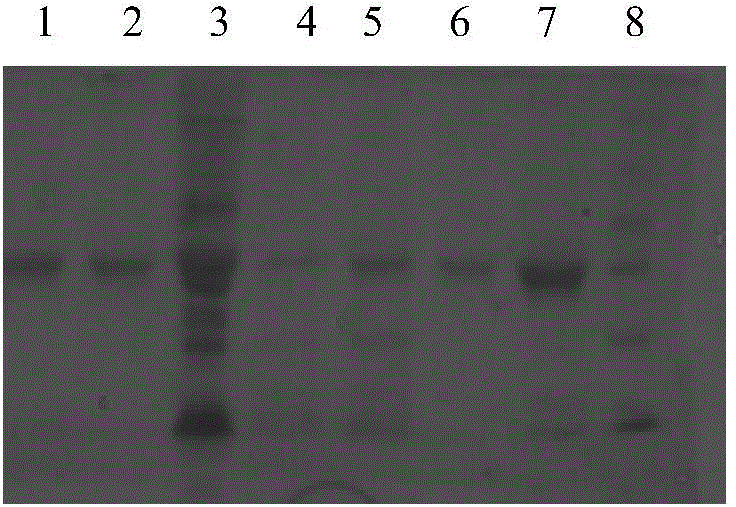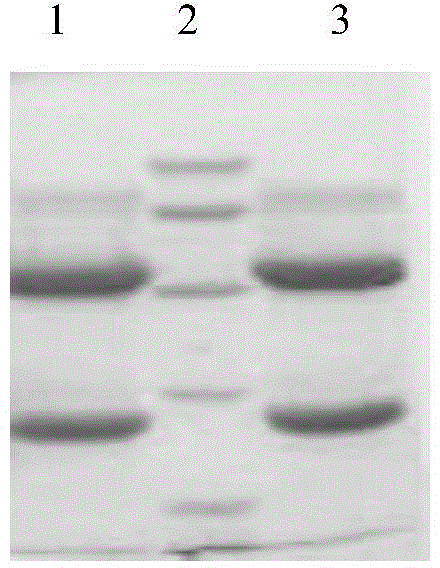Hybridoma cell capable of secreting anti-cystatin S monoclonal antibody as well as monoclonal antibody and application of hybridoma cell
A technology of monoclonal antibody and hybridoma cells, which is applied in the field of chemistry, can solve the problems of poor specificity, low sensitivity, and a ratio of less than 3%, and achieve the effect of high specificity and good sensitivity
- Summary
- Abstract
- Description
- Claims
- Application Information
AI Technical Summary
Problems solved by technology
Method used
Image
Examples
Embodiment 1
[0027] Embodiment 1, recombinant protein expression, purification and identification of Cystatin S
[0028] Using RT-PCR method from gastric cancer tissue, using the upstream primer of cloning primer: F: 5'-cccaagctt g ccaccatggcccggcctctg-3' (SEQ ID NO.1); the downstream primer is: 5'-cgcggatccttcttgacacctggaa-3' (SEQ ID NO.2) to clone the Cystatin S gene (SEQ ID NO.3), and then insert the cloned Cystatin S gene On the pc DNA3.1 vector containing His tag, Cystatin S-pc DNA3.1 was obtained. Then transform Cystatin S-pc DNA3.1 into DH5α, pick positive clones, expand and culture the picked positive clones, extract the recombinant plasmid Cystatin S-pc DNA3.1, and then perform enzyme digestion analysis with HindⅢ and BamHI, the results show Enzyme-digested fragments with the expected size were obtained. The correct recombinant Cystatin S-pc DNA3.1 was sequenced to confirm that the gene was correct, and then transfected into cos-7 cells with Lipofectamine2000. The positive clone...
Embodiment 2
[0030] Example 2, Preparation, Purification and Identification of Cystatin S Monoclonal Antibody
[0031]The Cystatin S recombinant protein purified in Example 1 was used to immunize BALB / c mice by subcutaneous injection. Each mouse was immunized with 50 μg of antigen each time, and the immune volume was 100 μl. The first immunization with cystatin S mixed with Freund's complete adjuvant 1:1 was immunized once every two weeks, and cystatin S was mixed with Freund's incomplete adjuvant 1:1 for a total of 3 immunizations; finally, after Cystatin S (without adjuvant ) intraperitoneal booster immunization (30 μg), 3 days later, the spleen cells of the immunized mice were taken, and then the spleen cells of the immunized mice and the myeloma cell line SP2 / 0 of the mouse were fused with PEG-4000. Hybridoma cells were selected on the culture plate, and cells producing anti-Cystatin S protein (Cystatin S monoclonal antibody) were identified by ELISA method; hybridoma cell line 5D2F2, ...
Embodiment 3
[0039] Example 3 Preparation, purification and identification of Cystatin S polyclonal antibody
[0040] Immunize rabbits with the Cystatin S recombinant protein purified in Example 1, 500 μg each, once every two weeks, three times in total; take the whole blood of the rabbits, and first use the ammonium sulfate precipitation method to preliminarily purify the immunoglobulin IgG from the rabbit serum , the specific steps are: first, centrifuge the rabbit serum at 4°C and 12000rpm for 20 minutes, and collect the supernatant; add an equal volume of saturated ammonium sulfate solution dropwise, stir at room temperature for 30 minutes, and then place it in a refrigerator at 4°C for 2 hours. During this process, a large amount of protein precipitated out. Centrifuge the solution at 12000 rpm for 20 minutes at 4°C, discard the supernatant, redissolve the precipitate with 4 times the original volume of serum in phosphate buffer, and centrifuge at 12000 rpm for 2 minutes at 4°C. Disc...
PUM
| Property | Measurement | Unit |
|---|---|---|
| molecular weight | aaaaa | aaaaa |
Abstract
Description
Claims
Application Information
 Login to View More
Login to View More - Generate Ideas
- Intellectual Property
- Life Sciences
- Materials
- Tech Scout
- Unparalleled Data Quality
- Higher Quality Content
- 60% Fewer Hallucinations
Browse by: Latest US Patents, China's latest patents, Technical Efficacy Thesaurus, Application Domain, Technology Topic, Popular Technical Reports.
© 2025 PatSnap. All rights reserved.Legal|Privacy policy|Modern Slavery Act Transparency Statement|Sitemap|About US| Contact US: help@patsnap.com



